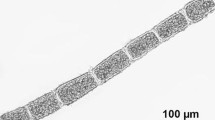Summary
Epipelic algae live freely on sediment surfaces, epipsammic algae live attached to grains in sandy sediments. Both groups may be buried by wave action and animal disturbance when they may find themselves in dark, deoxygenated layers. Epipelic algae, though tolerant of darkness for many days do not survive anaerobiosis for long and must rely on rapid movement to regain the sediment surface. Since they often are non-motile epipsammic algae cannot always move rapidly upwards. They tolerate both darkness and anaerobiosis, retaining considerable photosynthetic potential for several days in the complete absence of oxygen.
Similar content being viewed by others
References
Eaton, J.W., Moss, B.: The estimation of numbers and pigment content in epipelic algal populations. Limnol. Oceanogr. 11, 584–595 (1966)
Gargas, E.: Measurements of primary production, dark fixation and vertical distribution of the microbenthic algae in the Øresund. Ophelia 8, 231–253 (1970)
Harper, M.A.: Movement and migration of diatoms on sand grains. Brit. phycol. J. 4, 97–104 (1969)
Hickman, M., Round, F.E.: Primary production and standing crops of epipelic and epipsammic algae. Brit. phycol. J. 5, 247–255 (1970)
Mackereth, F.J.H.:Some methods of water analysis for limnologists. Sci. Publ. Freshwat. Biol. Assn. 21, 71 pp. (1963)
Moss, B.: Algae of two Somersetshire Pools. Standing crops of phytoplankton and epipelic algae as measured by cell numbers and chlorophyll a. J. Phycol. 5, 158–168 (1969)
Moss, B., Round, F.E.: Observations on standing crops of epipelic and epipsammic algal communities in Shear Water, Wilts. Brit. phycol. Bull. 3, 241–248 (1967)
Munro, A.L.S., Brock, R.S.: Distinction between bacterial and algal utilization of soluble substances in the sea. J. gen. Microbiol. 51, 35–42 (1968)
Round, F.E.: The ecology of benthic algae. In: Algae and man(D.F. Jackson, ed.), pp. 138–184. New York: Plenum 1964
Round, F.E.: The epipsammon; a relatively unknown freshwater algal association. Brit. phycol. Bull. 2, 456–462 (1965)
Round, F.E., Eaton, J.W.: Persistent, vertical-migration rhythms in benthic microflora. III. The rhythm of epipelic algae in a freshwater pond. J. Ecol. 54, 609–616 (1966)
Round, F.E., Happey, C.M.: Persistent, vertical-migration rhythms in benthic microflora. IV. A diurnal rhythm of the epipelic diatom association in non-tidal flowing water. Brit. phycol. Bull. 2, 463–471 (1965)
Round, F.E., Palmer, J.D.: Persistent, vertical-migration rhythms in benthic micro-flora. II. Field and laboratory studies on diatoms from the banks of the River Avon. J. mar. biol. Ass. U.K. 46, 191–214 (1966)
Stockner, J.G., Lund, J.W.G.: Live algae in postglacial lake deposits. Limnol. Oceanogr. 15, 41–58 (1970)
Author information
Authors and Affiliations
Rights and permissions
About this article
Cite this article
Moss, B. Adaptations of epipelic and epipsammic freshwater algae. Oecologia 28, 103–108 (1977). https://doi.org/10.1007/BF00346839
Received:
Issue Date:
DOI: https://doi.org/10.1007/BF00346839




